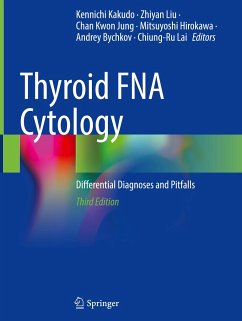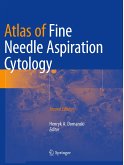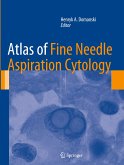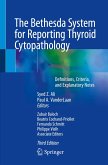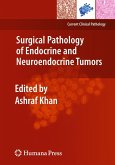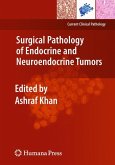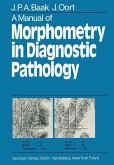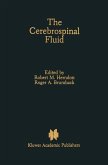Thyroid FNA Cytology
Differential Diagnoses and Pitfalls
Herausgegeben:Kakudo, Kennichi; Liu, Zhiyan; Jung, Chan Kwon; Hirokawa, Mitsuyoshi; Bychkov, Andrey; Lai, Chiung-Ru
Thyroid FNA Cytology
Differential Diagnoses and Pitfalls
Herausgegeben:Kakudo, Kennichi; Liu, Zhiyan; Jung, Chan Kwon; Hirokawa, Mitsuyoshi; Bychkov, Andrey; Lai, Chiung-Ru
- Gebundenes Buch
- Merkliste
- Auf die Merkliste
- Bewerten Bewerten
- Teilen
- Produkt teilen
- Produkterinnerung
- Produkterinnerung
This is the third edition of a well-received book that recapitulates the thyroid fine-needle aspiration (FNA) cytology. It covers the basics and critical principles of thyroid cytopathology, addresses technical aspects, and presents the latest breakthrough events in the field, including the new editions of the WHO classification of thyroid tumors and the Bethesda system for reporting thyroid cytopathology.
Thyroid FNA Cytology, The Third Edition is a practical handbook for cytopathologists, pathologists, cytotechnologists, endocrinologists, thyroid surgeons, radiologists, thyroid cancer…mehr
Andere Kunden interessierten sich auch für
![Atlas of Fine Needle Aspiration Cytology Atlas of Fine Needle Aspiration Cytology]() Atlas of Fine Needle Aspiration Cytology179,99 €
Atlas of Fine Needle Aspiration Cytology179,99 €![Atlas of Fine Needle Aspiration Cytology Atlas of Fine Needle Aspiration Cytology]() Atlas of Fine Needle Aspiration Cytology150,99 €
Atlas of Fine Needle Aspiration Cytology150,99 €![The Bethesda System for Reporting Thyroid Cytopathology The Bethesda System for Reporting Thyroid Cytopathology]() The Bethesda System for Reporting Thyroid Cytopathology53,99 €
The Bethesda System for Reporting Thyroid Cytopathology53,99 €![Surgical Pathology of Endocrine and Neuroendocrine Tumors Surgical Pathology of Endocrine and Neuroendocrine Tumors]() Ashraf Khan (ed.)Surgical Pathology of Endocrine and Neuroendocrine Tumors112,99 €
Ashraf Khan (ed.)Surgical Pathology of Endocrine and Neuroendocrine Tumors112,99 €![Surgical Pathology of Endocrine and Neuroendocrine Tumors Surgical Pathology of Endocrine and Neuroendocrine Tumors]() Surgical Pathology of Endocrine and Neuroendocrine Tumors82,99 €
Surgical Pathology of Endocrine and Neuroendocrine Tumors82,99 €![A Manual of Morphometry in Diagnostic Pathology A Manual of Morphometry in Diagnostic Pathology]() J. P. BaakA Manual of Morphometry in Diagnostic Pathology39,99 €
J. P. BaakA Manual of Morphometry in Diagnostic Pathology39,99 €![The Cerebrospinal Fluid The Cerebrospinal Fluid]() The Cerebrospinal Fluid149,99 €
The Cerebrospinal Fluid149,99 €-
-
-
This is the third edition of a well-received book that recapitulates the thyroid fine-needle aspiration (FNA) cytology. It covers the basics and critical principles of thyroid cytopathology, addresses technical aspects, and presents the latest breakthrough events in the field, including the new editions of the WHO classification of thyroid tumors and the Bethesda system for reporting thyroid cytopathology.
Thyroid FNA Cytology, The Third Edition is a practical handbook for cytopathologists, pathologists, cytotechnologists, endocrinologists, thyroid surgeons, radiologists, thyroid cancer patients, and their families. This edition covers more topics than the previous editions and invites authors from 20 countries from Asia, Europe, and America. It should serve as an individualized guide to readers practicing in various geographic areas with different medical settings and social resources. The book provides multiple chapters on differential diagnosis and pitfalls to show the unique approaches in many countries. The book will broaden their perspectives and serve as a foundation for further advancement in this field.
Hinweis: Dieser Artikel kann nur an eine deutsche Lieferadresse ausgeliefert werden.
Thyroid FNA Cytology, The Third Edition is a practical handbook for cytopathologists, pathologists, cytotechnologists, endocrinologists, thyroid surgeons, radiologists, thyroid cancer patients, and their families. This edition covers more topics than the previous editions and invites authors from 20 countries from Asia, Europe, and America. It should serve as an individualized guide to readers practicing in various geographic areas with different medical settings and social resources. The book provides multiple chapters on differential diagnosis and pitfalls to show the unique approaches in many countries. The book will broaden their perspectives and serve as a foundation for further advancement in this field.
Hinweis: Dieser Artikel kann nur an eine deutsche Lieferadresse ausgeliefert werden.
Produktdetails
- Produktdetails
- Verlag: Springer / Springer Nature Singapore / Springer, Berlin
- Artikelnr. des Verlages: 978-981-99-6781-0
- 3. Aufl.
- Seitenzahl: 864
- Erscheinungstermin: 24. Februar 2024
- Englisch
- Abmessung: 285mm x 215mm x 49mm
- Gewicht: 2569g
- ISBN-13: 9789819967810
- ISBN-10: 9819967813
- Artikelnr.: 68700350
- Herstellerkennzeichnung
- Springer-Verlag GmbH
- Tiergartenstr. 17
- 69121 Heidelberg
- ProductSafety@springernature.com
- Verlag: Springer / Springer Nature Singapore / Springer, Berlin
- Artikelnr. des Verlages: 978-981-99-6781-0
- 3. Aufl.
- Seitenzahl: 864
- Erscheinungstermin: 24. Februar 2024
- Englisch
- Abmessung: 285mm x 215mm x 49mm
- Gewicht: 2569g
- ISBN-13: 9789819967810
- ISBN-10: 9819967813
- Artikelnr.: 68700350
- Herstellerkennzeichnung
- Springer-Verlag GmbH
- Tiergartenstr. 17
- 69121 Heidelberg
- ProductSafety@springernature.com
Kennichi Kakudo, MD, PhD, FIAC is specialized in the diagnostic surgical pathology of endocrine organs. His scientific contributions were published in more than 300 peer-reviewed papers covering borderline thyroid tumors (PMID: 21070478, PMID: 21908930, PMID: 22360502, PMID: 27078145), intrathyroidal thymic carcinoma (PMID: 3260644, PMID: 17210519, PMID: 23233417), C cell carcinoma (PMID: 210736, PMID: 463561, PMID: 3103327), prognostic risk classification of thyroid carcinoma using the Ki67 labelling index (PMID: 20703465, PMID: 25195708, PMID: 33980775), and IgG4 thyroiditis (PMID: 20097712, PMID: 22555173, PMID: 31861966). He is an author of the fourth and fifth editions WHO Classification of thyroid tumors, the 2nd and 3rd editions of the Bethesda System for Reporting Thyroid Cytopathology, and the clinical guidelines by the Japanese Thyroid Association (JTA), including the JTA reporting system for thyroid FNA cytology (PMID: 24727657, PMID: 25722720). He is a founding member and the first president of the Asian Thyroid Working Group (PMID: 29046516, PMID: 29073758), which characterized Asian thyroid nodule practice in over 50 publications. One of the most well-known contributions of his scientific achievements is the diversity in thyroid nodule practice among countries, which was published in a recent commentary in Cancer Cytopathology (PMID: 37278105) and many more (PMID: 34060946, PMID: 32767256, PMID: 35159081, PMID: 33224851, PMID: 31556708, PMID: 29094782, PMID: 28486057). Zhiyan Liu, MD, PhD, MIAC is the Director of Department of Pathology Shanghai Sixth People's Hospital, China. She performs general surgical pathology, and is specialized in endocrine pathology and thyroid cytopathology. She is the vice president of Thyroid Cancer Committee of Chinese Society of Clinical Oncology, standing committee member in Tumor Pathology Committee of China Anti-cancer Association, a core member of Asian Thyroid Working Group, and member of the International Academy of Cytology and American Thyroid Association. Zhiyan Liu has published more than 100 peer-reviewed articles and book chapters. She is the first who proposed to set up a borderline tumor category, WDT-UB (well differentiated thyroid tumor uncertain clinical behavior, synonym of NIFTP) (PMID: 21070478), in the thyroid tumor classification in 2011, far before the NIFTP proposal. She is the first author of the first edition of Chinese Expert consensus on the cytopathological diagnosis of thyroid fine needle aspiration (version 2023). Andrey Bychkov, MD, PhD, FRCPath is the Director of Digital Pathology at Kameda Medical Center in Kamogawa, Japan. His subspecialty is thyroid pathology and he has contributed to the 2022 WHO classification of endocrine and neuroendocrine tumors. Dr. Bychkov is a co-founding member of the Asian Thyroid Working Group. He curates the thyroid chapter and serves as a deputy editor for PathologyOutlines, as well as an academic editor for severalinternational journals. He has published more than 100 journal articles and book chapters. Mitsuyoshi Hirokawa, MD, PhD, FIAC is the director of the Department of Diagnostic Pathology and Cytology at Kuma Hospital, Kobe, Japan. His specialty is thyroid cytology. He has diagnosed more than 7,000 cases of thyroid cytology and 1,700 cases of resected thyroid tissue annually. He has also performed more than 2000 thyroid aspirations annually. He has published more than 300 papers on thyroid cytology. He is one of the authors of the 3rd edition of The Bethesda System for Reporting Thyroid Cytopathology. Dr. Chan Kwon Jung is a professor of pathology at Seoul St. Mary's Hospital (The Catholic University of Korea). His main fields of expertise are thyroid pathology/cytopathology, molecular pathology, and digital pathology. Dr. Jung served as a coauthor on the fifth edition of the World Health Organization classification of thyroid tumors and has published more than 300 peer-reviewed articles. He is currently editor-in-chief for the Journal of Pathology and Translational Medicine and serves on the editorial boards of Thyroid, Endocrine Pathology, Cancers, and the Journal of Korean Medical Science. Dr. Chiung-Ru Lai is the past President of Taiwan Society of Clinical Cytology (2015-2021) and Taiwan Society of Pathology (2017-2023) and the current president of the Asian Thyroid Working Group. She has practiced surgical pathology and cytopathology in the Department of Pathology and Laboratory Medicine of Taipei Veterans General Hospital for over 30 years. She is one of the regional editors of Acta Cytologica and also serves as an editorial board member of Diagnostic Cytopathology. In addition to publishing scientific papers, she is also one of the authors of the 3rd edition of The Bethesda System for Reporting Thyroid Cytopathology.
I: Why Are There Significant Differences Among Us in Thyroid Nodule Practices?.- 1. Addressing the Impact of International Variation in Thyroid Cytology. Which Reporting System is best for Patients?.- 2. Diagnostic Criteria of Papillary Thyroid Carcinoma (PTC)-Type Nuclear Features Impacting Thyroid Fine Needle Aspiration (FNA) Cytology.- 3. Differences among thyroid FNA practices elucidated by meta-analyses of the literature.- 4. International Comparison Study of Thyroid Fine Needle Aspiration (FNA) Cytology Reporting System.- 5. Thyroid FNA terminology: Progress Towards a Single Unified International System for Thyroid FNA Reporting.- II: Reporting Systems of Thyroid FNA Cytology.- 6. Introduction to the third edition of the Bethesda System for Reporting Thyroid Cytopathology.- 7. The 2014 Italian Reporting System For Thyroid Cytology: Present and Future.- 8. The UK Royal College of Pathologists (RCPath) Thy Terminology for Reporting Thyroid FNA Cytology.- 9. Australian System forReporting Thyroid Cytology.- 10. The Japanese System Recommended by the Japan Thyroid Association.- 11. Risk Classification of Follicular Pattern Lesions in Thyroid FNA.- 12. Japanese Reporting System for Thyroid Aspiration Cytology (JRSTAC).- 13. Clinical Management for Follicular Neoplasm without Molecular Testing.- III: Classification of Thyroid Tumors.- 14. Histological Classification of Thyroid Tumors by the new 5th Edition WHO Classification.- 15. Low-risk Neoplasms in the 5th Edition of the WHO Classification of Thyroid Tumors.- 16. Clinically Insignificant Papillary Thyroid Carcinoma and Self-limiting Carcinoma that do not Harm Patients.- 17. Whole Tumor Capsule Is Prognostic Of Very Good Outcome In The Classical Variant Of Papillary Thyroid Cancer.- 18. A Framework For Approaching Cytologically Indeterminant Thyroid Nodules With Ras Mutations: A North American Perspective.- 19. Clinical Advantages and Limitations of Tumours Displaying Minimal and Extensive Vascular Invasion.-20. High-grade follicular cell-derived non-anaplastic thyroid carcinomas.- 21. Molecular classification of thyroid tumors and key molecular features to identify high-grade thyroid carcinomas.- IV: Criteria for Each Cytological Category.- 22. Specimen Adequacy and Non-diagnostic Thyroid Nodules.- 23. Cyst Fluid Only Samples.- 24. Cytology of benign thyroid aspirates.- 25. AUS/FLUS in the third edition Bethesda system.- 26. Cytological Diagnosis of FN Nodules.- 27. Diagnostic Criteria of Suspicious for Malignancy.- 28. Cytological Diagnoses of Malignancy and Nuclear Features of PTC.- V: Cytological Features of Thyroid Lesions.- 29. Diagnostic Clues for Thyroid Aspiration Cytology.- 30. False Positive in Thyroid FNA: Causes and How to Avoid Them.- 31. Papillae in thyroid aspirates.- 32. Papillary thyroid carcinoma on LBC preparation.- 33. Spindle cells in thyroid aspirates.- VI: Benign Lesions, Differential Diagnoses and Pitfalls.- 34. Thyroglossal Duct Cyst and Other Ectopic Thyroid Tissues in the Neck.- 35. Benign follicular pattern lesions (nodular hyperplasia).- 36. Infectious Thyroiditis.- 37. Diagnostic Considerations for Thyroid Nodules in Graves' Disease.- 38. Subacute Thyroiditis or Papillary Carcinoma.- 39. Hashimoto's Thyroiditis or Papillary Carcinoma.- VII: Low Risk Neoplasms, Differential Diagnoses and Pitfalls.- VII: Low Risk Neoplasms, Differential Diagnoses and Pitfalls.- 40. NIFTP in Asian practice.- 41. Role of FNA Cytology in Preoperative Prediction of NIFTP - Practical Experiences in North America.- 42. Hyalinizing Trabecular Tumor.- VIII: Papillary Thyroid Carcinoma, Differential Diagnoses and Pitfalls.- 43. Cystic Papillary Thyroid Carcinoma.- 44. Tall Cell Variant of Papillary Thyroid Carcinoma.- 45. Papillary carcinoma, Columnar Cell Variant---Diagnostic Pitfalls and Differential Diagnoses.- 46.Hobnail Papillary Thyroid Carcinoma.- 47. Solid/Trabecular Variant of Papillary Thyroid Carcinoma.- 48. Aggressive Subtypes of PTC, How to Handle themin FNA Cytology.- IX: High-Grade Carcinomas, Differential Diagnoses and Pitfalls.- 49. High-grade follicular-derived Carcinomas in FNA Cytology.- 50. Poorly Differentiated Carcinoma and Anaplastic Carcinoma of the Thyroid.- 51. Anaplastic Thyroid Carcinoma.- 52. Metastasis to Thyroid.- X: Other Thyroid Lesions, Differential Diagnoses and Pitfalls.- 53. Cribriform-Morular Thyroid Carcinoma.- 54. Oncocytic Cell Neoplasms in Hematoxylin-Eosin-Stained Samples.- 55. Hürthle Cell Neoplasms in Papanicolaou- and Romanowsky-Stained Specimens.- 56. Medullary (C Cell) Thyroid Carcinoma or Oxyphilic Follicular Neoplasms.- 57. Diagnosis of Medullary (C cell) Thyroid Carcinoma.- 58. Primary Thyroid Lymphoma.- 59. Rare Hematolymphoid Neoplasms of the Thyroid.- 60. Intrathyroid Thymic Carcinoma.- 61. Parathyroid Adenoma and Its Differential Diagnoses.- XI: How to Improve Diagnostic Performance in Thyroid FNA Cytology.- 62. How to Prepare Optimal FNA Samples.- 63. Staining Methods in Thyroid Cytology.-64. Fine Needle Aspiration Biopsy Complications.- 65. Liquid-Based Cytology Technique for Thyroid Cytology.- 66. Rapid on-site evaluation.- 67. Mobile rapid on-site evaluation.- 68. Low Cellularity Thyroid Fine Needle Aspiration Specimens: Differential Diagnosis, the Role of Ancillary Testing and Associated Diagnostic Challenges.- 69. The role of repeat FNA in indeterminate thyroid nodules.- 70. Frozen section and intraoperative imprint cytology.- 71. Core Needle Biopsy for the Diagnosis of Thyroid Nodules: Pathologic Aspects.- 72. Biochemical Test of Fine-needle Aspirate as an Adjunct to Cytological Diagnosis in Patients with Thyroid Cancer or Primary Hyperparathyroidism.- 73. Quality Control for Cytology Laboratory in the USA.- 74. Infection control in cytology practice and the COVID19 pandemic.- XII: Immunohistochemistry in Thyroid Nodule Practice.- 75. Cell blocks in cytopathology and its role in evaluation of thyroid aspirates.- 76. European experience and recommendations on immunohistochemistry on cytology specimens.- 77. Application of Immunocytochemistry in Thyroid Aspiration Cytology.- XIII: Molecular Tests in Thyroid Nodule Practice.- 78. Practice of Molecular Detection of Thyroid Fine Needle Aspiration Specimen in China.- 79. Experience in Molecular Testing Using FNA Cytology in EU Countries.- 80. Molecular Testing for Thyroid Nodules: The Experience at McGill University Teaching Hospitals in Canada.- 81. Thyroid Fine Needle Aspiration Cytology Molecular Testing in the USA.- 82. Molecular Target Therapy for Pathologists in Advanced Thyroid Carcinoma.- XIV: Image Technology in Thyroid Nodule Practice.- 83. Pathologic Basis for Thyroid Ultrasound.- 84. Ultrasonography of the thyroid gland.- 85. Nuclear imaging of the thyroid gland.- XV: Clinical Guidelines in Thyroid Nodule Practice.- 86. International Comparison Study of Clinical Guidelines for Thyroid Nodule Evaluation.- 87. How to Follow FNA-confirmed Benign Thyroid Nodules.- 88. Management of PapillaryMicrocarcinoma of the Thyroid.- 89. Active surveillance of low-risk thyroid carcinoma in Western practice.- XVI: Thyroid Carcinoma in Children and Young Adults.- 90. Thyroid Nodules in Children and Adolescents.- 91. Thyroid Carcinoma of Young Adults and Children.- 92. The role of thyroid FNA cytology in pediatric malignant lesions: Case illustrations and literature review.- XVII: Patient Oriented Thyroid Nodule Practice.- 93. One Stop Clinic for Thyroid Nodules.- 94. Caring for Patients with Thyroid Nodules: Preventing Overdiagnosis as a Harm of FNA Cytological Examinations.- 95. Consideration of Patients' Viewpoint and the Role of Pathologists in Reporting Diagnosis of Thyroid Carcinomas.
I: Why Are There Significant Differences Among Us in Thyroid Nodule Practices?.- 1. Addressing the Impact of International Variation in Thyroid Cytology. Which Reporting System is best for Patients?.- 2. Diagnostic Criteria of Papillary Thyroid Carcinoma (PTC)-Type Nuclear Features Impacting Thyroid Fine Needle Aspiration (FNA) Cytology.- 3. Differences among thyroid FNA practices elucidated by meta-analyses of the literature.- 4. International Comparison Study of Thyroid Fine Needle Aspiration (FNA) Cytology Reporting System.- 5. Thyroid FNA terminology: Progress Towards a Single Unified International System for Thyroid FNA Reporting.- II: Reporting Systems of Thyroid FNA Cytology.- 6. Introduction to the third edition of the Bethesda System for Reporting Thyroid Cytopathology.- 7. The 2014 Italian Reporting System For Thyroid Cytology: Present and Future.- 8. The UK Royal College of Pathologists (RCPath) Thy Terminology for Reporting Thyroid FNA Cytology.- 9. Australian System forReporting Thyroid Cytology.- 10. The Japanese System Recommended by the Japan Thyroid Association.- 11. Risk Classification of Follicular Pattern Lesions in Thyroid FNA.- 12. Japanese Reporting System for Thyroid Aspiration Cytology (JRSTAC).- 13. Clinical Management for Follicular Neoplasm without Molecular Testing.- III: Classification of Thyroid Tumors.- 14. Histological Classification of Thyroid Tumors by the new 5th Edition WHO Classification.- 15. Low-risk Neoplasms in the 5th Edition of the WHO Classification of Thyroid Tumors.- 16. Clinically Insignificant Papillary Thyroid Carcinoma and Self-limiting Carcinoma that do not Harm Patients.- 17. Whole Tumor Capsule Is Prognostic Of Very Good Outcome In The Classical Variant Of Papillary Thyroid Cancer.- 18. A Framework For Approaching Cytologically Indeterminant Thyroid Nodules With Ras Mutations: A North American Perspective.- 19. Clinical Advantages and Limitations of Tumours Displaying Minimal and Extensive Vascular Invasion.-20. High-grade follicular cell-derived non-anaplastic thyroid carcinomas.- 21. Molecular classification of thyroid tumors and key molecular features to identify high-grade thyroid carcinomas.- IV: Criteria for Each Cytological Category.- 22. Specimen Adequacy and Non-diagnostic Thyroid Nodules.- 23. Cyst Fluid Only Samples.- 24. Cytology of benign thyroid aspirates.- 25. AUS/FLUS in the third edition Bethesda system.- 26. Cytological Diagnosis of FN Nodules.- 27. Diagnostic Criteria of Suspicious for Malignancy.- 28. Cytological Diagnoses of Malignancy and Nuclear Features of PTC.- V: Cytological Features of Thyroid Lesions.- 29. Diagnostic Clues for Thyroid Aspiration Cytology.- 30. False Positive in Thyroid FNA: Causes and How to Avoid Them.- 31. Papillae in thyroid aspirates.- 32. Papillary thyroid carcinoma on LBC preparation.- 33. Spindle cells in thyroid aspirates.- VI: Benign Lesions, Differential Diagnoses and Pitfalls.- 34. Thyroglossal Duct Cyst and Other Ectopic Thyroid Tissues in the Neck.- 35. Benign follicular pattern lesions (nodular hyperplasia).- 36. Infectious Thyroiditis.- 37. Diagnostic Considerations for Thyroid Nodules in Graves' Disease.- 38. Subacute Thyroiditis or Papillary Carcinoma.- 39. Hashimoto's Thyroiditis or Papillary Carcinoma.- VII: Low Risk Neoplasms, Differential Diagnoses and Pitfalls.- VII: Low Risk Neoplasms, Differential Diagnoses and Pitfalls.- 40. NIFTP in Asian practice.- 41. Role of FNA Cytology in Preoperative Prediction of NIFTP - Practical Experiences in North America.- 42. Hyalinizing Trabecular Tumor.- VIII: Papillary Thyroid Carcinoma, Differential Diagnoses and Pitfalls.- 43. Cystic Papillary Thyroid Carcinoma.- 44. Tall Cell Variant of Papillary Thyroid Carcinoma.- 45. Papillary carcinoma, Columnar Cell Variant---Diagnostic Pitfalls and Differential Diagnoses.- 46.Hobnail Papillary Thyroid Carcinoma.- 47. Solid/Trabecular Variant of Papillary Thyroid Carcinoma.- 48. Aggressive Subtypes of PTC, How to Handle themin FNA Cytology.- IX: High-Grade Carcinomas, Differential Diagnoses and Pitfalls.- 49. High-grade follicular-derived Carcinomas in FNA Cytology.- 50. Poorly Differentiated Carcinoma and Anaplastic Carcinoma of the Thyroid.- 51. Anaplastic Thyroid Carcinoma.- 52. Metastasis to Thyroid.- X: Other Thyroid Lesions, Differential Diagnoses and Pitfalls.- 53. Cribriform-Morular Thyroid Carcinoma.- 54. Oncocytic Cell Neoplasms in Hematoxylin-Eosin-Stained Samples.- 55. Hürthle Cell Neoplasms in Papanicolaou- and Romanowsky-Stained Specimens.- 56. Medullary (C Cell) Thyroid Carcinoma or Oxyphilic Follicular Neoplasms.- 57. Diagnosis of Medullary (C cell) Thyroid Carcinoma.- 58. Primary Thyroid Lymphoma.- 59. Rare Hematolymphoid Neoplasms of the Thyroid.- 60. Intrathyroid Thymic Carcinoma.- 61. Parathyroid Adenoma and Its Differential Diagnoses.- XI: How to Improve Diagnostic Performance in Thyroid FNA Cytology.- 62. How to Prepare Optimal FNA Samples.- 63. Staining Methods in Thyroid Cytology.-64. Fine Needle Aspiration Biopsy Complications.- 65. Liquid-Based Cytology Technique for Thyroid Cytology.- 66. Rapid on-site evaluation.- 67. Mobile rapid on-site evaluation.- 68. Low Cellularity Thyroid Fine Needle Aspiration Specimens: Differential Diagnosis, the Role of Ancillary Testing and Associated Diagnostic Challenges.- 69. The role of repeat FNA in indeterminate thyroid nodules.- 70. Frozen section and intraoperative imprint cytology.- 71. Core Needle Biopsy for the Diagnosis of Thyroid Nodules: Pathologic Aspects.- 72. Biochemical Test of Fine-needle Aspirate as an Adjunct to Cytological Diagnosis in Patients with Thyroid Cancer or Primary Hyperparathyroidism.- 73. Quality Control for Cytology Laboratory in the USA.- 74. Infection control in cytology practice and the COVID19 pandemic.- XII: Immunohistochemistry in Thyroid Nodule Practice.- 75. Cell blocks in cytopathology and its role in evaluation of thyroid aspirates.- 76. European experience and recommendations on immunohistochemistry on cytology specimens.- 77. Application of Immunocytochemistry in Thyroid Aspiration Cytology.- XIII: Molecular Tests in Thyroid Nodule Practice.- 78. Practice of Molecular Detection of Thyroid Fine Needle Aspiration Specimen in China.- 79. Experience in Molecular Testing Using FNA Cytology in EU Countries.- 80. Molecular Testing for Thyroid Nodules: The Experience at McGill University Teaching Hospitals in Canada.- 81. Thyroid Fine Needle Aspiration Cytology Molecular Testing in the USA.- 82. Molecular Target Therapy for Pathologists in Advanced Thyroid Carcinoma.- XIV: Image Technology in Thyroid Nodule Practice.- 83. Pathologic Basis for Thyroid Ultrasound.- 84. Ultrasonography of the thyroid gland.- 85. Nuclear imaging of the thyroid gland.- XV: Clinical Guidelines in Thyroid Nodule Practice.- 86. International Comparison Study of Clinical Guidelines for Thyroid Nodule Evaluation.- 87. How to Follow FNA-confirmed Benign Thyroid Nodules.- 88. Management of PapillaryMicrocarcinoma of the Thyroid.- 89. Active surveillance of low-risk thyroid carcinoma in Western practice.- XVI: Thyroid Carcinoma in Children and Young Adults.- 90. Thyroid Nodules in Children and Adolescents.- 91. Thyroid Carcinoma of Young Adults and Children.- 92. The role of thyroid FNA cytology in pediatric malignant lesions: Case illustrations and literature review.- XVII: Patient Oriented Thyroid Nodule Practice.- 93. One Stop Clinic for Thyroid Nodules.- 94. Caring for Patients with Thyroid Nodules: Preventing Overdiagnosis as a Harm of FNA Cytological Examinations.- 95. Consideration of Patients' Viewpoint and the Role of Pathologists in Reporting Diagnosis of Thyroid Carcinomas.

